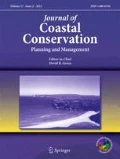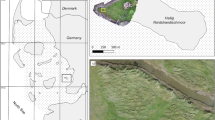Abstract
A low-cost standard drone (DJI™ Phantom 4 Pro) has been employed to map the ecosystems and features in coastal areas in the northern Persian Gulf. The Pix4Dcapture® mobile application was selected as a user friendly and simple app to perform an automated and customized drone flight over the selected study area in Nayband Bay, Bushehr province. The flight altitude was selected to be 100 m with 80% overlap for images, which led to the imaging of an area ~ 22 ha (413 × 525 m) in ~13 min (from takeoff to landing the drone). Agisoft™ Metashape PC software was then used to create the orthophoto mosaic from 213 taken photos. Consequently, the ground sampling distance (GSD) of the created orthophoto mosaic was ~3 cm which means it was possible to visually identify the features on the images with a size of 30 cm and more. The orthophoto mosaic was then converted to a topological GIS-based map (in the format of ESRI™ shapefile) by a 2-step procedure including a supervised image classification method coupled with manual editing with an on-screen visual editing method. The final results demonstrated that the overall accuracy of the classified mosaic raster map was 87.6% where the κ (Kappa coefficient) was 0.84. The results also showed that the applied methodology in this study can be used to differentiate the coastal ecosystems and features such as mangrove forests, vegetations, sandy beaches, and deep and shallow water bodies. As a comparison with alternative methods, the cost of implementing drone-based methodology was lower than field surveying and covers a larger area in less time.






Similar content being viewed by others
References
Bendell LI, Wan PC (2011) Application of aerial photography in combination with GIS for coastal management at small spatial scales: a case study of shellfish aquaculture. J Coast Conserv 15(4):417–431
Duffy J (2019) Coastal eye: monitoring coastal environments using lightweight drones. Doctoral dissertation, University of Exeter
Duffy JP, Pratt L, Anderson K, Land PE, Shutler JD (2018) Spatial assessment of intertidal seagrass meadows using optical imaging systems and a lightweight drone. Estuar Coast Shelf Sci 200:169–180
Feygels V, Johnson N, Kopilevich Y, Ramnath V, Marthouse R, Wozencraft J et al (2018, October) Features of airborne lidar surveys in clear ocean waters using Coastal Zone Mapping and Imaging Lidar (CZMIL). In: Remote Sensing of the Open and Coastal Ocean and Inland Waters, vol 10778, p 107780I International Society for Optics and Photonics
Fourqurean JW, Duarte CM, Kennedy H, Marbà N, Holmer M, Mateo MA, Apostolaki ET, Kendrick GA, Krause-Jensen D, McGlathery KJ, Serrano O (2012) Seagrass ecosystems as a globally significant carbon stock. Nat Geosci 5(7):505–509
Green E, Mumby P, Edwards A, Clark C (2000) Remote sensing: handbook for tropical coastal management. United Nations Educational, Scientific and Cultural Organization (UNESCO)
Kabiri K, Rezai H, Moradi M, Pourjomeh F (2014) Coral reefs mapping using parasailing aerial photography-feasibility study: Kish Island, Persian gulf. J Coast Conserv 18(6):691–699
Kabiri K, Rezai H, Moradi M (2018) Mapping of the corals around Hendorabi Island (Persian gulf), using Worldview-2 standard imagery coupled with field observations. Mar Pollut Bull 129(1):266–274
Kabiri K, Rezai H, Moradi M (2020) A drone-based method for mapping the coral reefs in the shallow coastal waters–case study: Kish Island, Persian gulf. Earth Sci Inf In press https://doi.org/10.1007/s12145-020-00507-z
Klemas V (2011) Remote sensing techniques for studying coastal ecosystems: an overview. J Coast Res 27(1):2–17
Nandy S, Kushwaha SPS (2011) Study on the utility of IRS 1D LISS-III data and the classification techniques for mapping of Sunderban mangroves. J Coast Conserv 15(1):123–137
Pérez-Alberti A, Pires A, Chaminé HI (2019) Shoreline and coastal terrain mapping. In: Finkl CW, Makowski C (eds) Encyclopedia of coastal science. Encyclopedia of Earth Sciences Series, Springer, Cham
Rodriguez W, Feller IC, Cavanaugh KC (2016) Spatio-temporal changes of a mangrove–saltmarsh ecotone in the northeastern coast of Florida, USA. Global Ecology and Conservation 7:245–261
Ruwaimana M, Satyanarayana B, Otero V, Muslim AM (2018) The advantages of using drones over space-borne imagery in the mapping of mangrove forests. PLoS One 13(7):e0200288
Seifert E, Seifert S, Vogt H, Drew D, Van Aardt J, Kunneke A, Seifert T (2019) Influence of drone altitude, image overlap, and optical sensor resolution on multi-view reconstruction of forest images. Remote Sens 11(10):1252
Tuell G, Barbor K, Wozencraft J (2010, May) Overview of the coastal zone mapping and imaging lidar (CZMIL): a new multisensor airborne mapping system for the US Army Corps of Engineers. In: Algorithms and Technologies for Multispectral, Hyperspectral, and Ultraspectral Imagery XVI, vol 7695, p 76950R International Society for Optics and Photonics
Ventura D, Bruno M, Lasinio GJ, Belluscio A, Ardizzone G (2016) A low-cost drone based application for identifying and mapping of coastal fish nursery grounds. Estuar Coast Shelf Sci 171:85–98
Ventura D, Bonifazi A, Gravina MF, Belluscio A, Ardizzone G (2018) Mapping and classification of ecologically sensitive marine habitats using unmanned aerial vehicle (UAV) imagery and object-based image analysis (OBIA). Remote Sens 10(9):1331
Woodget AS, Austrums R, Maddock IP, Habit E (2017) Drones and digital photogrammetry: from classifications to continuums for monitoring river habitat and hydromorphology. Wiley Interdiscip Rev Water 4(4):e1222
Wozencraft J, Millar D (2005) Airborne lidar and integrated technologies for coastal mapping and nautical charting. Mar Technol Soc J 39(3):27–35
Zimudzi E, Sanders I, Rollings N, Omlin C (2019) Segmenting mangrove ecosystems drone images using SLIC superpixels. Geocarto Int 34(14):1648–1662
Acknowledgments
This research was supported by the Iranian National Institute for Oceanography and Atmospheric Science [grant no. INIOAS-397-011-06-09-01]. Dr. A. Maghsoodloo is acknowledged for his kind supports of this study. The author also wishes to thank Mr. H. Bazyar in Bushehr for his contribution to the field observations in Nayband Bay.
Author information
Authors and Affiliations
Corresponding author
Additional information
Publisher’s note
Springer Nature remains neutral with regard to jurisdictional claims in published maps and institutional affiliations.
Rights and permissions
About this article
Cite this article
Kabiri, K. Mapping coastal ecosystems and features using a low-cost standard drone: case study, Nayband Bay, Persian gulf, Iran. J Coast Conserv 24, 62 (2020). https://doi.org/10.1007/s11852-020-00780-6
Received:
Revised:
Accepted:
Published:
DOI: https://doi.org/10.1007/s11852-020-00780-6




